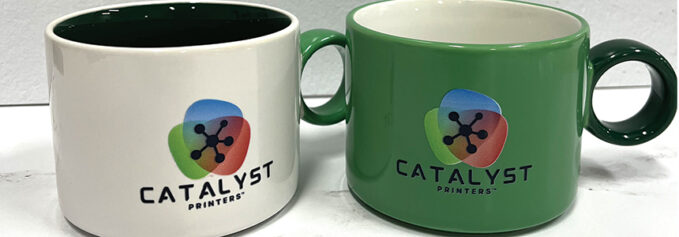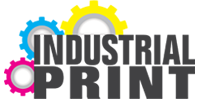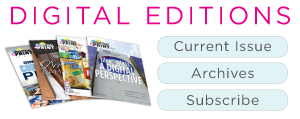
by Cassandra Balentine
Inkjet continues to push the envelope when it comes to the materials it can successfully decorate. Direct to object (DTO) printing utilizes inkjet technologies compatible with a variety of surfaces. However, certain items are nuanced, such as cylindrical with handles.
Above: The DPI Laboratory Catalyst Nanos and Catalyst Aventra flatbed printers are capable of flatbed and rotary printing, and the Nanos adds roll-based printing in a smaller footprint.
“With the wide variety of handled mugs and tumblers made from ceramic, plastic, and metal, the demand for UV printers capable of efficiently decorating these drinkware items continues to grow,” offers Michael Perrelli, sales director, Innovative Digital Systems (IDS).
Lon Riley, founder/CEO, The DPI Laboratory, explains that cylindrical objects are typically printed using a rotary attachment to maximize the size of the imprint. “With a handle, the rotation distance is limited, so you are relegated to a smaller print area, either with a shorter rotation or a traditional flatbed print.”
While there’s clearly a market for printing onto handled items, such as mugs, tumblers, and other drinkware, Derek LaChance, digital product manager, Inkcups, says it remains a relatively niche segment within the broader DTO landscape. “The key for many print businesses is flexibility,” continues LaChance.
Niche Segments
Dedicated DTO printers as well as certain flatbed configurations are able to handle cylindrical DTO printing. Depending on coverage needs—full or single-sided decoration—for printing to products with handles, a dedicated solution may be necessary.
Segmentation in DTO is driven by demand for specialized, high-margin applications like custom drinkware, promotional items, and more.
Perrelli points out that print providers have options. “Some of the DTO printers we offer provide a range of versatility capable of printing on everything from cylindrical cosmetic packaging and shot glasses to larger items like beer growlers. Others, like our dedicated handled object printer, were designed to serve a market segment that had previously been overlooked until we launched the machine last year.”
Before the release of dedicated solutions like IDS’ RevHDL, companies looking to UV print on handled objects typically relied on flatbed printers, which only allowed for a small print area—something many users found limiting. “The introduction of the RevHDL expands the printable area around the mug, unlocking creative possibilities that weren’t achievable before,” explains Perrelli.
“In our experience, most customers look to increase their versatility at the same time as prioritizing speed and lower volume orders. This is where modularity comes into its own with flexible, modular solutions,” notes LaChance.
James Bullington, CTO, LSINC Corporation, points out that while printing to handled items can be niche, the market is not yet oversaturated. “There are specific items that require unique solutions whether it be based on size, material, or substrate type.”
LSINC’s PeriH is a functional addition to its DTO offering that directly addresses the requests of numerous clients for the ability to digitally print directly to an object with handles. “Its ability to print on multiple types of materials makes it a versatile addition to the promotional product market,” shares Bullington.
Flatbed printers like the Mimaki USA, Inc. UJF Series print to handled items, but with limitations. “Because of the geometry, most handled objects can only be printed on one side at a time unless custom fixtures or pre/post handling are used. That said, Mimaki’s long distance (LD) print profiles are a significant advantage—allowing clean printing on surfaces with up to 4.5 millimeters of variation, which helps maintain quality even when printing near edges or contours,” says Hugo Gonzalez, senior IP segment specialist, Mimaki USA.
While handled items are popular, Gonzalez considers specifically built printers niche solutions. “In most cases, there are existing technologies that handle this need well. For example, UV direct to film (DTF) printers like the UJV300DTF-75 are ideal for curved or handled objects, applying detailed graphics with full wraparound coverage—something flatbeds and cylindrical attachments typically can’t accommodate.”
The custom tooling, drop table, and High Throw technology on Inkcups’ X5-T High Throw flatbed printer enables users to expand their application range without the need to invest in a new printer for every object type. “The X5-T can accommodate a variety of objects, including items with handles, and was developed in response to customer demand. This enables print providers to meet demand for personalization without taking up additional floor space or budget for highly specialized equipment,” adds LaChance.
William J. White, SVP, global sales and marketing, Apex Machine Company & Desco Machine Company LLC, says Apex designs custom machines for individual customers’ needs. While many have the same base and may share a lot of design commonality, White says it designs its systems to provide a turnkey solution for the unique requirement of that project. “Many times we have had customers come to us because an ‘off the shelf’ solution doesn’t accommodate their needs when needing to run parts with handles.”
O&PM Europa BV’s DTO solution can print to items with or without handles.
Riley feels that if anything, DTO printers are becoming less segmented and more capable. “True multifunction is a high bar when you talk about DTO because there are so many different media possibilities. It is impossible to do everything well.”
Both DPI’s Catalyst Nanos and Catalyst Aventra printers print directly to items with handles, however they are subject to the physical limitations of the machine. “That is, the handle cannot pass into the linear plane of the printhead,” says Riley.
The Catalyst Nanos printer has flatbed, rotary, UV DTF, and roll printing capability in the same small footprint, accomplishing what once required three or four separate machines.
Gonzalez feels that segmentation in this space is in response to increased demand for specialized output. “When there’s a strong market like with custom tumblers or promotional drinkware, it makes sense for dedicated systems to exist. But the core of the industry still leans toward flexible, multi-application equipment. Printers that can adapt to multiple object types, materials, and workflows remain the most attractive option for shops that need to maximize return on investment (ROI) and floor space.”
Longer Runs
A big advantage of DTO printing is that it makes it possible to print a variety of volume sizes from print runs of one to 500 without reducing cost effectiveness. “Additionally, the ability to print a single item cost effectively means that prior to completing a job of 200 the print provider can print a test without significant cost or time impact. This is especially beneficial given the variable nature of personalized print,” says LaChance.
Bullington points out that in today’s web-driven marketplace, order sizes continue to shrink, meaning DTO equipment must be flexible via its tooling and changeover. “Doing so aggregates the quantities of numerous items with only the incremental tooling cost for each item.”
Dursun Acun, sales director, O&PM Europa, believes that DTO systems will not only replace labels or silkscreen systems, but that the whole logistics around the products is more efficient. “The breakeven strongly depends on a total business case.”
White suggests that many times the breakeven point is much lower than anticipated. “Especially since the pandemic, many customers have lost faith in outsourcing and contract print houses have been extremely backordered thus our customers are looking to bring the printing in house. There are also many internal factors like the ability to avoid handling products more than once and being able to provide ‘rush’ jobs versus having to wait on the print houses.”
As with all print technologies, Riley says the longer the runs, the more cost effective the machines become on a per-job basis, as a function of turnover time, prepress, and retooling or adjustments required between jobs. “While machine cost, ink cost, maintenance, and uptime are, of course, big factors in profitability—time is an equally large consideration.”
Handled items can follow the same breakeven path through flexibility. “A quantity is difficult to assess. The PeriH’s flexibility supports items as small as a tea cup to as large as a 40oz travel tumbler. The margins on the latter are considerably different than that of a plastic camping cup,” offers Bullington.
Gonzalez feels that handled items can be quite efficient to print even on a flatbed, when set up properly. “Using a jig-based workflow, it’s possible to print 20 coffee mugs at a time. On a printer like the UJF-7151 Plus II, using an LD profile, you can decorate about half the exposed side of each mug in one pass. Depending on resolution, the entire jig takes about five to eight minutes per side, offering excellent throughput without the need for a dedicated machine.”
Perrelli finds it difficult to quantify a breakeven point as customers leverage the equipment for different purposes. “For example, we have one customer that uses the RevHDL as a means to move the drinkware product. Without the customization on handled prospects, they know their customers will seek out other brands who do offer it. On the opposite end of that spectrum, we have customers who charge a premium to provide one-up custom drinkware with high-quality prints. The breakeven point for a customer like that would happen much sooner, but it doesn’t make the other sales model less valuable.”
Because not all decorators charge a premium for the decoration, but in some cases as a means to move product, Perrelli stresses that whether or not a item has a handle still makes the breakeven hard to quantify. “For the customers that do charge a premium for the decoration, I think the same ROI percentage applies to handled tumblers that many customers see on their non-handled, powder coated tumbler. There is a much higher inherent value of a decorated, powder coated tumbler or travel mug when compared to a pint glass or ceramic mug,” suggests Perrelli.
Ink Considerations
Whether or not an item has a handle, different print surfaces have different surface energy, which can make materials more or less ink receptive. “We use dyne level as a general gauge and recommend different pretreatments based upon the media type. That said—some, but not all UV inks are DTF compatible. UV DTF provides an alternative to direct print that can extend the capabilities of the printer and facilitate decoration of handled items,” offers Riley.
The key considerations for ink selection often lie more in the preparation steps and processes required to achieve dishwashable results. “While the ink certainly plays a role, the pretreatment process can vary significantly. For example, a powder coated travel mug requires a different approach than a ceramic mug prior to printing,” notes Perrelli.
As with most digital printer applications the choice of ink is driven as much by the printhead choice and target substrates. “The need to apply each color plane sequentially as the media is moved beneath the next color station requires proper matching of surface energy to avoid bleed and ensure adhesion. This differs from helical and interlaced printing where multiple colors could be applied in single or multiple passes,” says Bullington.
When considering ink for DTO, it is important to factor in durability needs. “Items like mugs need inks that resist abrasion and moisture. LH-100 UV ink is a good choice. It’s highly resistant to solvents and scratching, making it a great option for rigid handled items. That said, most UV prints are recommended for handwashing. If dishwasher resistance is important, the LH-100 of the UJF Series machine and ELH-100 ink used in the UJV300DTF-75 will offer some good performance under repeated exposure to heat and moisture, but again, the official recommendation is handwashing,” shares Gonzales.
DTO inkjet UV printers typically print with CMYK, white, and varnish. LaChance says there is no specific ink needed for handled items as the same formulations used in standard digital printing work perfectly fine for high throw applications. “It’s worth noting here that there is no universal ink for all DTO applications and the requirements and considerations are dependent on the substrate.”
O&PM Europa BV D2O devices use water-based inks.
Curing Considerations
Similar to the ink used, whether or not a job requires pre- or post-curing technologies depend on the application, the substrate being decorated, and durability requirements. “Some substrates require additional help to achieve excellent adhesion, and this is where pre-treatment comes in. Getting pretreatment right demands understanding of the end application and knowledge of the substrate in order to pair the right technique with the right ink and technology, so it’s advisable to work with an equipment manufacturer with expertise in pretreatment across varied applications, inks, substrates, and printing methods,” offers LaChance.
Riley points out that with UV printers, there is generally no need for post-cure techniques. “We do recommend different types of primer or adhesion promoters for materials with lower surface energy such as glass, polypropylene, and some metals. These pretreatments may be applied mechanically or jetted onto the surface, depending upon the primer and the printer technology.”
Perrelli stresses that the need for pre- or post-curing depends on the product. “For powder coated tumblers, a jettable primer that is applied inline on the printer is advised. For ceramic mugs, they must be flame treated offline before heading to the printer,” shares Perrelli.
Apex & Desco Machine generally includes any necessary pre/post treating/curing on the system itself.
DTO Options
There are pros and cons to utilizing a dedicated DTO object printer versus a flatbed for printing to cylindrical objects with handles and vice versa.
“The main advantage of a dedicated printer is optimization, faster setup, and alignment for a specific product type, like drinkware or bottles. But the tradeoff is flexibility. These machines typically serve a single application, making them harder to justify unless you’re operating in high volumes,” summarizes Gonzales. “By contrast, flatbeds and UV DTF solutions offer more versatility across object shapes, sizes, and materials. For many print providers—especially those in custom goods, signage, or promotional markets—investing in a flexible system provides a better long-term return and allows the shop to evolve with demand.”
However, when the need is there, the biggest advantage of a dedicated DTO press for handled, cylindrical items is its ability to deliver full-color digital decoration including gradients, photos, and complex designs on a range of handled objects. “That applies to various colors—not limited by white substrates—and the ability to print on a range of materials—stainless steel, tritan, powder coat, ceramic, glass, etc. The only real disadvantage applies to a small number of customers that want to use a singular printer to print on all their drinkware,” adds Perrelli.
Oct2025, Industrial Print Magazine



